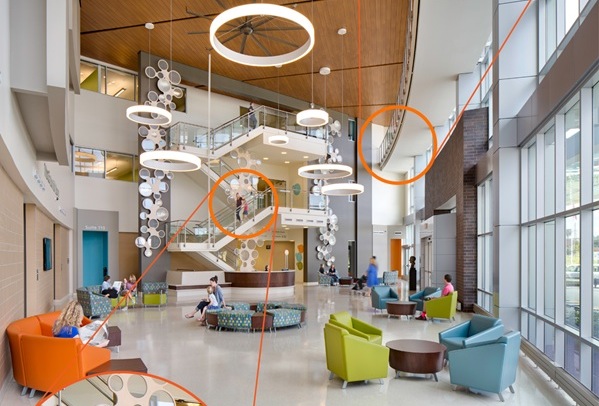or many, one New Year's resolution made just about every year is about taking better care of themselves and being more active. For those of us that work in an office environment, sitting at our desks day-in and day-out can impede our ability to successfully meet these goals, or is used as an excuse as to why we lead more sedentary lifestyles.
But, as a designer working on the design of workplace environments, I’m also keen on the idea of how many workplaces are being designed today to help support and encourage more active lifestyles of employees.
According to the CDC, the average full-time working American spends more than one-third of their day, five days per week at the workplace. With sedentary jobs having increased 83% since 1950, physically active jobs now make up less than 20% of our workforce. For these jobs that require little or no physical activity, investing in corporate wellness creates a healthier, happier workplace and shows you care about your company’s most important assets--the people.
Employees are the driving force that keeps a company in motion. Designing spaces with the intent to encourage healthier employee behaviors can mean a decrease in sick days, lower insurance costs and increased employee retention.
So how can designers help to deliver results that don’t involve employees being deskbound or sedentary for hours on end? Through the concept of active design we have the ability to help drive positive and healthy changes in the workplace.
GS&P’s work on the new Lentz Public Health Center in Nashville, Tenn., serves as a model of how those progressive and healthy changes can be made. Employees of the Metro Health Department are given the opportunity to exercise 30 minutes a day, three times a week during office hours in a wellness program called Wise Moves. By signing up, Health Department employees agree to track their activity and certain health metrics through a database that is assessed yearly for the program effectiveness.
But, much like that new gym membership you may have signed up for earlier this month, the real benefit of design elements incorporated for employee wellness only comes from the actual use and engagement of those elements. Having a gym located on your route home from the office makes it more likely you’ll actually go rather than if you have to drive 10 miles out of your way to get there. Similarly certain design elements were incorporated into the Lentz facility in a manner that makes the “healthier” alternative the preferred and most available manner in which to interact with the building.
These elements were incorporated into the Lentz facility as a way to further the overall department mission of encouraging healthy, active, and sustainable living. The design not only benefits the programs inside the building, but aids in enhancing the community and leading by example.
They are also design elements that can be incorporated into nearly any workplace environment to help promote healthier lifestyle choices by employees of all types. What sorts of design elements are you seeing incorporated into work spaces to promote more active employees? How are you and your staff being more active during the day?
You can also check out this short video made last year to capture the progressive and sustainable features of the Lentz facility. Watch and learn more about the project and see some footage of these design elements and more.
About the Author: Ann Trent is an accomplished senior architect with more than 20 years of experience in all aspects of project delivery. She has a thorough understanding of the architectural design process and uses these skills as both a project manager and client leader for GS&P’s corporate clients. Her experience includes planning and management of large capital projects for the city of Nashville. Her work at GS&P has built on her experience with complex projects with multiple stakeholders. More on Trent.
More from Author
Gresham Smith | Oct 16, 2024
How AI can augment the design visualization process
Blog author Tim Beecken, AIA, uses the design of an airport as a case-study for AI’s potential in design visualizations.
Gresham Smith | Aug 17, 2023
How to design for adaptive reuse: Don’t reinvent the wheel
Gresham Smith demonstrates the opportunities of adaptive reuse, specifically reusing empty big-box retail and malls, many of which sit unused or underutilized across the country.
Gresham Smith | May 24, 2023
Designing spaces that promote enrollment
Alyson Mandeville, Higher Education Practice Leader, argues that colleges and universities need to shift their business model—with the help of designers.
Gresham Smith | Apr 24, 2023
Smart savings: Commissioning for the hybrid workplace
Joe Crowe, Senior Mechanical Engineer, Gresham Smith, shares smart savings tips for facility managers and building owners of hybrid workplaces.
Gresham Smith | Mar 20, 2023
3 ways prefabrication doubles as a sustainability strategy
Corie Baker, AIA, shares three modular Gresham Smith projects that found sustainability benefits from the use of prefabrication.
Gresham Smith | Jan 19, 2023
Maximizing access for everyone: A closer look at universal design in healthcare facilities
Maria Sanchez, Interior Designer at Gresham Smith, shares how universal design bolsters empathy and equity in healthcare facilities.
Gresham Smith | Dec 20, 2022
Designing for a first-in-the-world proton therapy cancer treatment system
Gresham Smith begins designing four proton therapy vaults for a Flint, Mich., medical center.
Gresham Smith | Nov 21, 2022
An inside look at the airport industry's plan to develop a digital twin guidebook
Zoë Fisher, AIA explores how design strategies are changing the way we deliver and design projects in the post-pandemic world.
Gresham Smith | Feb 13, 2022
Helping maximize project dollars: Utility coordination 101
In this post, I take a look at the utility coordination services our Transportation group offers to our clients in an attempt to minimize delays and avoid unforeseen costs.
Gresham Smith | May 7, 2021
Private practice: Designing healthcare spaces that promote patient privacy
If a facility violates HIPAA rules, the penalty can be costly to both their reputation and wallet, with fines up to $250,000 depending on the severity.
















